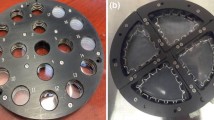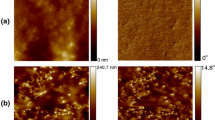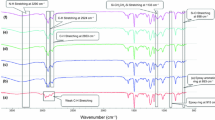Abstract
Nanoparticles are increasingly used in polymer coatings (i.e., nanocoatings) to improve multiple properties including the mechanical, electrical, gas barrier, and ultraviolet (UV) resistance of traditional coatings. These high performance nanocoatings are often used in outdoor environments. However, because polymers are susceptible to degradation by weathering elements, nanoparticles in a nanocoating may be released into the environment during its life cycle, which potentially poses an environmental health and safety concern and may hinder application of these advanced coatings. This study presents protocols and experimental technique to quantify the release of nanosilica from epoxy nanocoating as a function of UV exposure. Specimens of an epoxy coating containing 5% untreated nanosilica in specially designed holders were exposed to UV radiation (295–400 nm) in a well-controlled high-intensity UV chamber. Exposed specimens were removed at specified UV dose intervals for measurements of coating chemical degradation, mass loss, nanosilica accumulation on specimen surface, and nanosilica release as a function of UV dose. Measurement of nanosilica release was accomplished by (a) periodically spraying UV-exposed specimens with water, (b) collecting runoff water/released particles, and (c) analyzing collected solutions by inductively coupled plasma-optical emission spectrometry using a National Institute of Standards and Technology (NIST)-developed protocol. Results demonstrated that the amount of nanosilica release was substantial and increased rapidly with UV dose. Mass loss, chemical degradation, and silica accumulation on specimen surface also increased with UV dose.











Similar content being viewed by others
References
McNally, T, Pötschke, P (eds.), Polymer-Carbon Nanotube Composites, Preparation, Properties, and Applications. Woodhead Publishing, Philadelphia, 2011
Potts, JR, Dreyer, DR, Bielawski, CW, Ruoff, RS, “Graphene-Based Polymer Nanocomposites.” Polymer, 52 5–25 (2011)
Pavlidou, S, Papaspyrides, CD, “A Review on Polymer-Layered Silicate Nanocomposites.” Prog. Polym. Sci., 33 1119–1198 (2008)
Zou, H, Wu, SS, Shen, J, “Polymer/Silica Nanocomposites: Preparation, Characterization, Properties, and Applications.” Chem. Rev., 108 (3) 893–3957 (2008)
Nanomaterials in Plastics and Advanced Polymers. Market Report # 52, April, 2012, Future Markets, Inc.
Moukwa, M, “Fascinating Technology Advances on the Anvil in the Coatings Industry.” Chem. Ind. Digest, 24 142–153 (2011)
Nel, A, Xia, T, Mädler, L, Li, N, “Toxic Potential of Materials at the Nanolevel.” Science, 311 622–627 (2006)
Poland, C, et al., “Carbon Nanotubes Introduced into the Abdominal Cavity of Mice Show Asbestos-Like Pathogenicity in a Pilot Study.” Nat. Nanotechnol., 3 423–428 (2008)
Maynard, AD, “Nanotechnology: Assessing the Risks.” Nanotoday, 2 22–33 (2006)
Aschberger, K, et al., “Review of Carbon Nanotubes Toxicity and Exposure—Appraisal of Human Health Risk Assessment Based on Open Literature.” Crit. Rev. Toxicol., 40 (9) 759–790 (2010)
Adams, LK, Lyon, DY, Alvarez, PJJ, “Comparative Ecotoxicity of Nanoscale TiO2, SiO2, and ZnO Water Suspensions.” Water Res., 40 3527–3532 (2006)
McCarthy, J, Inkielewicz-Stępniak, I, Corbalan, JJ, Radomski, MW, “Mechanisms of Toxicity of Amorphous Silica Nanoparticles on Human Lung Submucosal Cells In Vitro: Protective Effects of Fisetin.” Chem. Res. Toxicol., 25 2227–2235 (2012)
Nishimori, H, et al., “Silica Nanoparticles as Hepatotoxicants.” Eur. J. Pharma. Biopharm., 72 469–501 (2009)
Leem, J, Mahendra, S, Alvarez, PL, “Nanomaterials in the Construction Industry: A Review of Their Applications and Environmental Health and Safety Considerations.” ACSNano, 4 3580–3589 (2010)
Kohler, AR, Som, C, Hellanda, A, Gottschalk, F, “Studying the Potential Release of Carbon Nanotubes Throughout the Application Life Cycle.” J. Clean. Prod., 16 927–937 (2008)
Nowack, B, et al., “Potential Scenarios for Nanomaterial Release and Subsequent Alteration in the Environment.” Environ. Toxicol. Chem., 31 50–59 (2012)
Nowack, B, “Potential Release Scenarios for Carbon Nanotubes Used in Composites.” Environ. Int., 59 1–11 (2013)
Petersen, EJ, et al., “Potential Release Pathways, Environmental Fate, and Ecological Risks of Carbon Nanotubes.” Environ. Sci. Technol., 45 (23) 9837–9856 (2011)
Schlagenhauf, L, et al., “Release of Carbon Nanotubes from an Epoxy-Based Nanocomposite During an Abrasion Process.” Environ. Sci. Technol., 46 (13) 7366–7372 (2012)
Bello, D, et al., “Exposure to Nanoscale Particles and Fibers During Machining of Hybrid Advanced Composites Containing Carbon Nanotubes.” J. Nanoparticle Res., 11 231–249 (2009)
Bello, D, et al., “Characterization of Exposures to Nanoscale Particles and Fibers During Solid Core Drilling of Hybrid Carbon Nanotube Advanced Composites.” Int. J. Occup. Environ. Health, 16 (4) 434–450 (2010)
Gohler, D, et al., “Characterization of Nanoparticle Release from Surface Coatings by the Simulation of a Sanding Process.” Ann. Occup. Hyg., 54 615–624 (2010)
Vorbau, M, Hillemann, L, Stintz, M, “Method for the Characterization of the Abrasion Induced Nanoparticle Release into Air from Surface Coatings.” J. Aerosol Sci., 40 209–217 (2009)
Golanski, L, et al., “Characterization of Abrasion-Induced Nanoparticle Release from Paints into Liquids.” J. Phys. Conf. Ser., 304 012062 (2011)
Sachse, S, et al., “The Effect of Nanoclay on Dust Generation During Drilling of PA6 Nanocomposites.” J. Nanomater., (2012). doi:10.151155/2012/189386
Kamal, M, Huang, B, “Natural and Artificial Weathering of Polymers.” In: Hamid, S, Amin, M, Maadhah, A (eds.) Handbook of Polymer Degradation, pp. 127–178. Marcel Dekker, New York, 1992
Nguyen, T, Wohlleben, W, Sung, L, Mechanisms of Aging and Release from Weathered Nanocomposites, Chap. 14. Taylor & Francis, Boca Raton. ISBN 978-1-46-656786-3, 2014
Nguyen, T, Pelligrin, B, Gu, X, Shapiro, A, Chin, J, “Degradation and Nanofiller Release of Polymer Nanocomposites Exposed to Ultraviolet Radiation.” In: Reichert, T (ed.) Natural and Artificial Ageing of Polymers, pp. 149–162. Gesellschaft für Umweltsimulation, Pfinztal, 2009
Nguyen, T, et al., “Characterization of Surface Accumulation and Release of Nanosilica During Irradiation of Polymer Nanocomposites by Ultraviolet Light.” J. Nanosci. Nanotechnol., 12 6202–6215 (2012)
Gorham, J, Nguyen, T, Bernard, C, Stanley, D, Holbrook, D, “Photo-Induced Surface Transformations of Silica Nanocomposites.” Surf. Interface Anal., 44 1572–1581 (2012)
Nguyen, T, et al., “Fate of Nanoparticles During Life Cycle of Polymer Nanocomposites.” J. Phys. Conf. Ser., 304 012060 (2011)
Petersen, EJ, et al., “Methods to Assess the Impact of UV Irradiation on the Surface Chemistry and Structure of Multiwall Carbon Nanotube Epoxy Nanocomposites.” Carbon, 69 194–205 (2014)
Villar, G, et al., “Monitoring Migration and Transformation of Nanomaterials in Polymeric Composites During Accelerated Aging.” J. Phys. Conf. Ser., 429 012044 (2013)
Wohlleben, W, et al., “A Pilot Interlab Comparison of Methods to Simulate Aging of Nanocomposites and to Detect Fragments Released.” Environ. Chem., 11 (4) 402–418 (2014)
Wohlleben, W, et al., “On the Life Cycle of Nanocomposites: Comparing Released Fragments and Their In Vitro Hazards from Three Release Mechanims and Four Nanocomposites.” Small, 7 2384–2395 (2011)
Busquets-Fite, M, et al., “Exploring Release and Recovery of Nanomaterials from Commercial Polymeric Nanocomposites.” J. Phys. Conf. Ser., 429 012048 (2013)
Hirth, S, Cena, L, Cox, G, Tomovic, Z, Peters, T, Wohlleben, W, “Scenarios and Methods That Induce Protruding or Released CNTs After Degradation of Composite Materials.” J. Nanoparticle Res., 15 1504–1519 (2013)
Zuin, S, Gaiani, M, Ferrari, A, Goalnski, L, “Leaching of Nanoparticles from Experimental Water-Borne Paints Under Laboratory Test Conditions.” J. Nanoparticle Res., 16 2185 (2014)
Al-Kattan, A, et al., “Release of TiO2 from Paints Containing Pigment-TiO2 and Nano-TiO2 by Weathering.” Environ. Sci. Proc. Impact, 15 2186–2193 (2013)
Al-Kattan, A, et al., “Characterization of Materials Release into Water from Paint Containing Nano-SiO2.” Chemosphere, (2014). doi:10.1016/j.chemosphere.2014.02.005
Chin, E, et al., “Accelerated UV Weathering Device Based on Integrating Sphere Technology.” Rev. Sci. Instrum., 75 4951 (2004)
Harrick, NJ, Internal Reflection Spectroscopy, 2nd ed., p. 30. Harrick Scientific Corporation, Ossining, 1979
Rabek, JF, Polymer Photodegradation: Mechanism and Experimental Methods, pp. 185–216. Chapman & Hall, New York, 1995
Bellenger, V, Verdu, J, “Oxidative Skeleton Breaking in Epoxy–Amine Networks.” J. Appl. Polym. Sci., 30 363–374 (1985)
Rivaton, A, Moreau, L, Gardette, JL, “Photo-oxidation of Phenoxy Resins at Long and Short Wavelengths—Mechanisms of Formation of Photoproducts.” Polym. Degrad. Stab., 58 (3) 333–339 (1997)
Mailhot, N, Morlat-Theias, S, Ouahioune, M, Gardette, JL, “Study of the Degradation of an Epoxy/Amine Resin, 1. Photo- and Thermo-chemical Mechanisms.” Macromol. Chem. Phys., 206 (5) 575–584 (2005)
Nguyen, T, et al., “Degradation Modes of Crosslinked Coatings Exposed to Photolytic Environment.” J. Coat. Technol. Res., 10 (1) 1–14 (2013)
Gu, X, et al., “Linking Accelerated Laboratory Test with Outdoor Performance Results for a Model Epoxy Coating System.” In: Martin, JW, Ryntz, RA, Chin, J, Dickie, RA (eds.) Service Life Prediction of Polymeric Materials, Global Perspectives, pp. 3–28. Springer, New York, 2009
Colthup, NB, Daly, LH, Wiberley, SE, Introduction to Infrared and Raman Spectroscopy, 3rd ed., p. 355. Academic Press, New York, 1990
Fowkes, FM, “Acid–Base Interactions in Polymer Adhesion.” In: Mittal, KL (ed.) Physical Aspects of Polymer Surfaces, Vol. 2, pp. 583–603. Plenum Press, New York, 1983
Chen, L, Gu, X, Fasolka, M, Martin, JW, Nguyen, T, “Effects of Humidity and Sample Surface Free Energy on AFM Probe-Sample Interactions and Lateral Force Microscopy Image Contrast.” Langmuir, 25 3494–3503 (2009)
Palmese, GR, McCoullough, RL, “Kinetic and Thermodynamic Considerations Regarding Interphase Formation in Thermosetting Composite Systems.” J. Adhesion, 44 29–49 (1994)
Author information
Authors and Affiliations
Corresponding author
Rights and permissions
About this article
Cite this article
Sung, L., Stanley, D., Gorham, J.M. et al. A quantitative study of nanoparticle release from nanocoatings exposed to UV radiation. J Coat Technol Res 12, 121–135 (2015). https://doi.org/10.1007/s11998-014-9620-9
Published:
Issue Date:
DOI: https://doi.org/10.1007/s11998-014-9620-9




